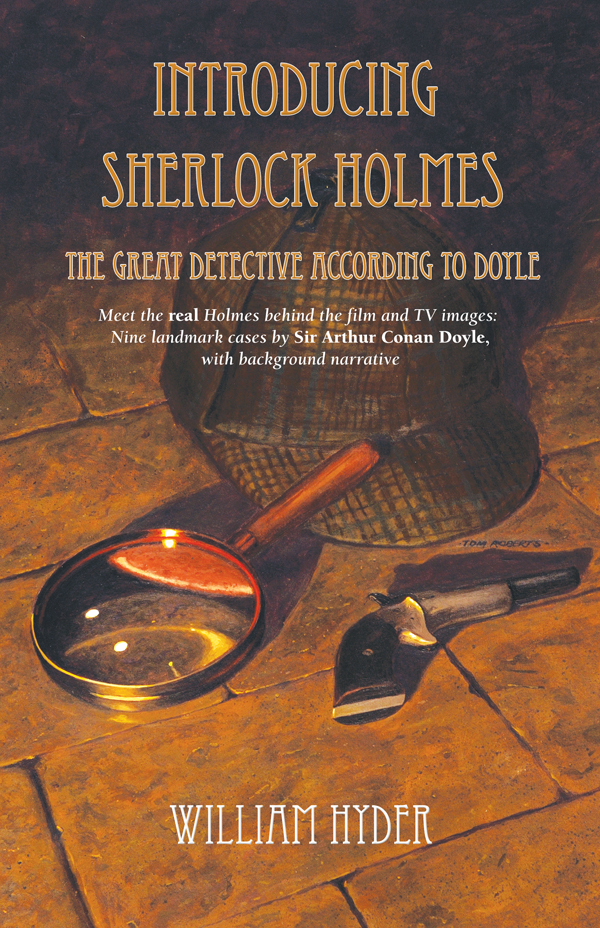

Cover by Tom Roberts
The real Sherlock Holmes behind
the film and TV images: Nine landmark cases
by Sir Arthur Conan Doyle, with
background narration
E-Book pdf file with hyperlinks $12.99 (The file will be shipped to you with Memeo-Send)


William Hyder became a Sherlockian at age 10 when he saw Basil Rathbone in The Hound of the Baskervilles.
Born and raised in New York City, he worked at the Baltimore Sun for many years, serving as television editor, copy editor and columnist, and writing book reviews, theater reviews and feature stories. He enjoyed a concurrent career in Baltimore-Washington theater and broadcasting as performer, announcer, director and conductor.
A member of the Six Napoleons of Baltimore and the Baker Street Irregulars of New York, Mr. Hyder is the author of From Baltimore to Baker Street. He edited The Napoleon Bust Business Again (volume four in the B.S.I. Manuscript Series) and has contributed many articles to Sherlockian journals in the United States and the United Kingdom.
To Begin With
1. The Real Sherlock Holmes
2. Holmes at His Height:
"The Six Napoleons"3. Two Brothers
4. Career Advice:
"The Gloria Scott"5. A Tragedy in Sussex
6. New Directions
7. His First Bow:
"The Musgrave Ritual"8. Scandal at Scotland Yard
9. A Course of Lectures
10. "Dr. Watson, Mr. Sherlock Holmes":
A Study in Scarlet (opening chapters)11. Forging a Partnership
12. A Word About Money
13. Early Days in Baker Street:
"The Speckled Band"14. Rescuing a Royal:
"The Beryl Coronet"15. The Arrangement
16. Meeting Mycroft:
"The Greek Interpreter"17. Failure: The Ripper Murders
18. Recognition:
"The Man With the Twisted Lip"19. The Later Years
20. Serving the Queen:
"The Bruce-Partington Plans"21. Sherlock Holmes Lives! Societies and Scholarship
How It’s Pronounced, What It Means
To Begin With ...
Holmes! Is it really you?"A stunned Dr. Watson exclaimed those words in "The Adventure of the Empty House." For three years he had thought his friend, the world’s most famous detective, was dead.
Holmes had plunged into the depths of the Reichenbach Falls in the mountains of Switzerland, locked in hand-to-hand combat with his arch-enemy, Professor Moriarty. Watson had sadly reported this tragic news to his readers in an earlier narrative called "The Final Problem."
Now here was Holmes, alive in Watson’s study, standing before the doctor and smiling in amusement.
*
No, Holmes had not really been killed in the Reichenbach Falls. He survived, returned to London, and pursued his distinguished career for many more years.
In a way he’s still alive today. The name of Sherlock Holmes is known not only by the world’s English-speaking people but by people of every nationality in every part of the globe. But how well do they know the real Sherlock Holmes?
The thin, hawk-nosed face ... the deerstalker cap and Inverness cape ... the pipe and the magnifying glass. These icons turn up in print advertisements and TV commercials, selling every product from insurance to automobiles. Even if no face is depicted — even if an ad shows nothing more than a pipe and a magnifying glass — the reader instantly thinks of Sherlock Holmes.
Holmes first appeared on the stage in 1899. Plays about him are still being written and performed today. His adventures were dramatized on the radio as early as 1930 in the United States, with the British Broadcasting Corporation following in 1943.
Cartoonists have depicted Holmes in comic books and cartoon strips. Writers of pastiches (novels that try to imitate the style of the original Holmes adventures) have taken him up in a balloon, flown him to Dallas to look into the assassination of President Kennedy, and even sent him into space.
The hero of silent movies produced from 1900 into the 1920s, Holmes became even more popular in talking pictures. With the coming of television he turned up in dramatic series and made-for-TV features. Now, in the 21st century, he continues to pursue his investigations on multiplex theater screens.
Millions of people are familiar with the keen, energetic Holmes portrayed in the movies by Basil Rathbone ... the neurotic, uptight Holmes of Granada TV’s Jeremy Brett ... Robert Downey Jr.’s scruffy, unshaved Holmes on the wide screen ... Benedict Cumberbatch’s computer-era Holmes in the BBC television series.
Faced with these many and varied apparitions of the great detective, some of his admirers find themselves echoing Dr. Watson’s words: "Holmes! Is it really you?"
Because all these imaginative and entertaining portrayals are merely illusions — shadows of a single, primal figure.
The real Sherlock Holmes — the brilliant, conflicted, ego-driven Victorian who struggled with a drug habit — is more fascinating than any of the later imitations. He lives in stories published by a British novelist and historian, Sir Arthur Conan Doyle. And he’s well worth getting to know.
In this book we introduce the authentic Sherlock Holmes, not the imitations of stage, screen, television, radio, and pastiche. Of the sixty cases reported by his friend and colleague, Dr. John H. Watson, and brought to the reading public by Conan Doyle, we present nine that illustrate landmarks or turning points in Holmes’s career.
Dr. Watson is silent about many aspects of Holmes’s life — his parents, his early life, his education, his reasons for becoming a detective. To fill these gaps we offer biographical assumptions drawn from a long study of the great detective and his Victorian world. The result is a continuous account of Holmes’s career with Doyle, the master storyteller, providing the basic narration.
Many writers have investigated Holmes’s life and career and come up with valuable deductions. The ones we are particularly indebted to are given credit in the text and listed at the back of the book. So are our sources of historical background.
Now it’s time to meet the real Sherlock Holmes.
Other Volumes in the Series:
Another book by the same author: